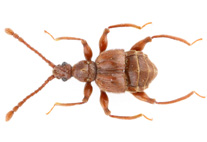Abstract
The Oriental pselaphine genus Horniella Raffray, 1905 (tribe Tyrini: subtribe Somatipionina) is redefined and revised. Twenty-five new species are described: H. centralis Yin & Li, sp. n., H. confragosa Yin & Li, sp. n., H. dao Yin & Li, sp. n., H. hongkongensis Yin & Li, sp. n., H. nakhi Yin & Li, sp. n., H. schuelkei Yin & Li, sp. n., H. sichuanica Yin & Li, sp. n., H. simplaria Yin & Li, sp. n., and H. tianmuensis Yin & Li, sp. n. from China, H. himalayica Yin & Li, sp. n. from Nepal and North India, H. asymmetrica Yin & Li, sp. n., H. burckhardti Yin & Li, sp. n., H. intricata Yin & Li, sp. n., H. kaengkrachan Yin & Li, sp. n., H. khaosabap Yin & Li, sp. n., H. loebli Yin & Li, sp. n., H. phuphaman Yin & Li, sp. n., H. prolixo Yin & Li, sp. n., and H. schwendingeri Yin & Li, sp. n. from Thailand, H. philippina Yin & Li, sp. n. from the Philippines, H. awana Yin & Li, sp. n., H. gigas Yin & Li, sp. n., H. pilosa Yin & Li, sp. n., and H. smetanai Yin & Li, sp. n. from Malaysia, and H. cibodas Yin & Li, sp. n. from Indonesia. The two previously described species, H. hirtella Raffray, 1901 (type species) from Sri Lanka and H. falcis Yin & Li, 2010 from China are redescribed, and a lectotype is designated for H. hirtella. Illustrations of habitus and important diagnostic features, an identification key, and distributional maps for all species are provided. Eleven unidentified species represented only by females are left unnamed. Illustrations of the habitus and the genital complex, and label data of these species are given to facilitate future study. All available data indicates that species of Horniella typically inhabit leaf litter of various kinds of forests, and can be most efficiently collected by sifting and use of Winkler-Moczarski extractors.

